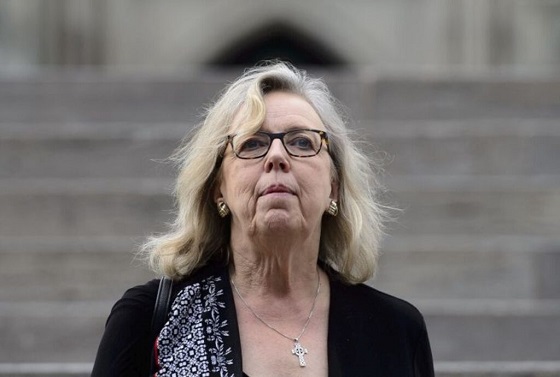Business
Enbridge to pay Bad River band $5.1M in Line 5 profits, move pipeline by 2026: judge
This June 29, 2018 photo shows tanks at the Enbridge Energy terminal in Superior, Wisc. A U.S. judge in that state has ordered the Calgary-based energy giant to pay an Indigenous band US$5.1 million and to remove the Line 5 pipeline from the band’s property within three years. THE CANADIAN PRESS/AP-Jim Mone
By James McCarten in Washington
Calgary-based Enbridge Inc. must pay an Indigenous band in Wisconsin more than US$5 million in Line 5 profits and relocate the controversial cross-border pipeline within the next three years, a U.S. judge says.
A rupture on territory that belongs to the Bad River Band of the Lake Superior Chippewa would constitute a clear public nuisance under federal law, district court Judge William Conley said in a decision late Friday.
But while the order affirms that Enbridge has been trespassing on Bad River land since 2013, when certain permits for the 70-year-old pipeline were allowed to lapse, it stops short of causing “economic havoc” with an immediate shutdown.
“The use of trespass on a few parcels to drive the effective closure of all of Line 5 has always been about a tail wagging a much larger dog,” Conley writes in his opinion.
In other words, there are “much larger public policy issues” surrounding cross-border pipelines like Line 5 that the band’s arguments, while valid, lack the power to overcome, he said.
Those issues “involve not only the sovereign rights of the band, but the rights of multiple states and international relations between the United States and Canada.”
Enbridge has already agreed to reroute the line, an essential energy conduit for much of the U.S. Midwest as well as Ontario and Quebec. But Conley wants that project completed more quickly than currently planned.
“Considering all the evidence, the court cannot countenance an infinite delay or even justify what would amount to a five-year forced easement with little realistic prospect of a reroute proceeding even then,” he wrote.
“The court will give Enbridge an additional three years to complete a reroute. If Enbridge fails to do so, the three years will at least give the public and other affected market players time to adjust to a permanent closure of Line 5.”
Enbridge’s lawyers continue to dispute the finding that the company is trespassing on Indigenous territory and intend to appeal the decision, and may also request a stay pending its outcome, said spokesperson Juli Kellner.
“Enbridge’s position has long been that a 1992 contract between Enbridge and the band provides legal permission for the line to remain in its current location,” Kellner said.
“Timely government permit approvals” would be necessary to complete the reroute within three years, while relocating the pipe currently on Bad River territory would take about a year, she added.
Any shutdown before then “would jeopardize the delivery of reliable and affordable energy to U.S. and Canadian families and businesses, disrupt local and regional economies, and violate the Transit Pipeline Treaty.”
Talks between the two countries have been ongoing for months under the terms of that treaty, a 1977 agreement that effectively prohibits either side from unilaterally closing off the flow of hydrocarbons.
In prior court documents, Enbridge has accused the band of being focused on a single outcome: the permanent closure of the pipeline on their territory “while refusing much less extreme alternative measures.”
The band argues that several weeks of spring flooding along the Bad River has washed away so much of the riverbank and supporting terrain that a breach is “imminent” and a shutdown order more than justified.
Enbridge insists the dangers are being overstated — and even if they were real, the company’s court-ordered contingency plan, which spells out the steps it would take, would be a far more rational solution.
Conley’s order Friday included tweaks to that plan to establish a more “conservative” threshold for the conditions that would trigger it, such as lower water levels and flow rates on the river.
“The court is particularly concerned that Enbridge’s plan does not account for inevitable delays that could occur due to weather conditions, supply and equipment problems and human error.”
Enbridge has also been rebuffed repeatedly in its efforts to perform remedial work on the site, which would include using sandbags and trees to fortify the riverbanks —decisions the band has defended as its sovereign right.
Heavy flooding that began in early April washed away significant portions of the riverbank where Line 5 intersects the Bad River, a meandering, 120-kilometre course that feeds Lake Superior and a complex network of ecologically delicate wetlands.
The band has been in court with Enbridge since 2019 in an effort to compel the pipeline’s owner and operator to reroute Line 5 around its traditional territory — something the company has already agreed to do.
But the flooding has turned a theoretical risk into a very real one, the band argued, and time is now of the essence.
Line 5 meets the river just past a location the court has come to know as the “meander,” where the riverbed snakes back and forth multiple times, separated from itself only by several metres of forest and the pipeline itself.
But it was clear both from Friday’s order and an in-person hearing last month, when Conley openly questioned the band’s motives, that he faults the band for rejecting Enbridge’s proposed plans to mitigate the danger.
“The band has refused to approve any of Enbridge’s remediation and prevention proposals, much less proposed even one project of its own to prevent or at least slow further erosion at the meander,” he wrote.
The neighbouring state of Michigan, led by Attorney General Dana Nessel, has been waging its own war against Line 5, fearing a leak in the Straits of Mackinac, the ecologically delicate waterway where the pipeline crosses the Great Lakes.
The economic arguments against shutting down the pipeline, which carries 540,000 barrels of oil and natural gas liquids daily across Wisconsin and Michigan to refineries in Sarnia, Ont., are by now well-known.
Line 5’s defenders, which include the federal government, say a shutdown would cause major economic disruption across the Prairies and the U.S. Midwest, where it provides feedstock to refineries in Michigan, Ohio and Pennsylvania.
It also supplies key refining facilities in Ontario and Quebec, and is vital to the production of jet fuel for major airports on both sides of the Canada-U.S. border, including Detroit Metropolitan and Pearson International in Toronto.
This report by The Canadian Press was first published June 17, 2023.
Business
Ottawa’s gun ‘buyback’ program will cost billions—and for no good reason

From the Fraser Institute
By Gary Mauser
The government told Cape Bretoners they had two weeks to surrender their firearms to qualify for reimbursement or “buyback.” The pilot project netted a grand total of 22 firearms.
Five years after then-prime minister Justin Trudeau banned more than 100,000 types of so-called “assault-style firearms,” the federal government recently made the first attempt to force Canadians to surrender these firearms.
It didn’t go well.
The police chief in Cape Breton, Nova Scotia, volunteered to run a pilot “buyback” project, which began last month. The government told Cape Bretoners they had two weeks to surrender their firearms to qualify for reimbursement or “buyback.” The pilot project netted a grand total of 22 firearms.
This failure should surprise no one. Back in 2018, a survey of “stakeholders” warned the government that firearms owners wouldn’t support such a gun ban. According to Prime Minister Carney’s own Privy Council Office the “program faces a risk of non-compliance.” And federal Public Safety Minister Gary Anandasangaree was recently recorded admitting that the “buyback” is a partisan maneuver, and if it were up to him, he’d scrap it. What’s surprising is Ottawa’s persistence, particularly given the change in the government and the opportunity to discard ineffective policies.
So what’s really going on here?
One thing is for certain—this program is not, and never has been, about public safety. According to a report from the federal Department of Justice, almost all guns used in crimes in Canada, including in big cities such as Toronto, are possessed illegally by criminals, with many smuggled in from the United States. And according to Ontario’s solicitor general, more than 90 per cent of guns used in crimes in the province are illegally imported from the U.S. Obviously, the “buyback” program will have no effect on these guns possessed illegally by criminals.
Moreover, Canadian firearms owners are exceptionally law-abiding and less likely to commit murder than other Canadians. That also should not be surprising. To own a firearm in Canada, you must obtain a Possession and Acquisition Licence (PAL) from the RCMP after initial vetting and daily monitoring for possible criminal activity. Between 2000 and 2020, an average of 12 PAL-holders per year were accused of homicide, out of approximately two million PAL-holders. During that same 10-year period, the PAL-holder firearms homicide rate was 0.63 (per 100,000 PAL-holders) compared to 0.72 (per 100,000 adult Canadians)—that’s 14 per cent higher than the rate for PAL-holders.
In other words, neither the so-called “assault-style firearms” nor their owners pose a threat to the public.
And the government’s own actions belie its claims. If these firearms are such a threat to Canadians, why slow-roll the “buyback” program? If inaction increased the likelihood of criminality by law-abiding firearms owners, why wait five years before launching a pilot program in a small community such as Cape Breton? And why continue to extend the amnesty period for another year, which the government did last month at the same time its pilot project netted a mere 22 firearms?
To ask those questions is to answer them.
Another question—how much will the “buyback” program cost taxpayers?
The government continues to block any attempt to disclose the full financial costs (although the Canadian Taxpayers Federation has launched a lawsuit to try to force the government to honour its Access to Information Act request). But back in 2020 the Trudeau government said it would cost $200 million to compensate firearms owners (although the Parliamentary Budget Officer said compensation costs could reach $756 million). By 2024, the program had spent $67.2 million—remember, that’s before it collected a single gun. The government recently said the program’s administrative costs (safe storage, destruction of hundreds of thousands of firearms, etc.) would reach an estimated $1.8 billion. And according to Carney’s first budget released in November, his government will spend $364 million on the program this fiscal year—at a time of massive federal deficits and debt.
This is reminiscent of the Chretien government’s gun registry fiasco, which wound up costing more than $2 billion even after then-justice minister Allan Rock promised the registry program would “almost break even” after an $85 million initial cost. The Harper government finally scrapped the registry in 2012.
As the Carney government clings to the policies of its predecessor, Canadians should understand the true nature of Ottawa’s gun “buyback” program and its costs.
Business
Recent price declines don’t solve Toronto’s housing affordability crisis

From the Fraser Institute
By Jake Fuss and Austin Thompson
House prices in Toronto are declining. But the city’s affordability crisis is far from over—and government policies will likely make it worse.
While most Torontonians know there’s a crisis, the numbers make it clear. According to our new study, in 2023 (the latest year of available data), a family earning the city’s median after-tax income ($60,510) had to save $216,240 (the equivalent of 42.9 months of its after-tax income) for a 20 per cent downpayment on a typical home of any type (single-detached, semi-detached, condominium). But even if that family could somehow clear this monumental hurdle, it then had to dedicate 110.2 per cent of its after-tax income for monthly mortgage payments ($5,557)—a financial impossibility, unless the family can share housing costs (e.g. live-in tenants) or rely on financial support from elsewhere.
At this point, some long-time Toronto residents might recall their own difficult home purchase and think, “Hasn’t it always been this bad?” But just a decade ago, the hurdles weren’t nearly as high.
For example, in 2014 in Toronto, a 20 per cent downpayment cost 26.4 months of median after-tax family income—not 42.9 months. And the monthly mortgage payment on a typical home purchase required 56.0 per cent of median after-tax family income—not 110.2 per cent. So yes, typical homes have been broadly unaffordable for median-income-earning Toronto families for years, but it’s way worse now.
For Torontonians priced out of homeownership, renting has not offered much relief. In 2023, Toronto had the least affordable rents in Canada. The monthly cost of the median rental unit was $1,750, equal to 34.7 per cent of the median after-tax family income. That’s up from $1,110 (or 27.7 per cent of after-tax income) in 2014.
Fast-forward to today, and Torontonians should view reports of “crashing” home prices in the proper context. Typical home prices peaked at $1.27 million in the first quarter of 2022. By the second quarter of 2025, they had fallen to $1.00 million. That’s a marked decline, but prices remain well above pre-pandemic levels and far beyond the reach of most typical families.
And while the fall in house prices hasn’t been enough to restore affordability, it has caused a steep contraction in homebuilding as builders take a more cautious approach to development at a time when the city still needs more new homes to improve affordability.
This unhealthy dynamic, where price declines weigh heavily on housing construction, is made worse by government policy. Despite hundreds of millions of taxpayer dollars spent on housing initiatives by the federal government, the Ford government and Toronto City Hall, key provincial and municipal policies continue to impose needless costs and restrictions on new housing.
For example, Toronto homebuilders must endure costly wait times of more than two years for municipal approvals—more than three times longer than in Vancouver and seven times longer than in Edmonton. New high-rise developments in Toronto face municipal charges of $134,900 per unit compared to $38,100 in Ottawa and $6,900 in Edmonton. Meanwhile, the Ford government has backed away from several critical recommendations from its own Housing Task Force, which would make it easier to build more and denser housing, such as allowing fourplexes provincewide without special approval.
Of course, federal immigration policy, particularly over the last five years, has increased demand for new homes in Toronto and across the country. But even so, if not for lengthy approval processes, sky-high fees and restrictive land-use policies, many more new homes would be built in Toronto today despite declining prices. Homes only get built when buyers can cover the cost of construction plus a reasonable return on investment for developers. But when governments drive up costs, increase uncertainty and claim a significant share of the final sale price through fees and charges, projects that might otherwise proceed can become financially unviable. The result is less new housing, fewer options for buyers and a slower path to improved affordability.
To help improve housing affordability, Toronto needs a steady flow of new homebuilding. Torontonians should demand faster approvals, lower fees and more sensible rules on what types of homes can be built.
-

 National19 hours ago
National19 hours agoMedia bound to pay the price for selling their freedom to (selectively) offend
-

 Bruce Dowbiggin18 hours ago
Bruce Dowbiggin18 hours agoSometimes An Ingrate Nation Pt. 2: The Great One Makes His Choice
-

 Business7 hours ago
Business7 hours agoRecent price declines don’t solve Toronto’s housing affordability crisis
-

 Daily Caller8 hours ago
Daily Caller8 hours agoTech Mogul Gives $6 Billion To 25 Million Kids To Boost Trump Investment Accounts
-

 Business6 hours ago
Business6 hours agoOttawa’s gun ‘buyback’ program will cost billions—and for no good reason
-

 Energy2 days ago
Energy2 days agoELZABETH MAY HAS IT WRONG: An Alberta to Prince Rupert Oil Pipeline Will Contribute to Greater Global Oil Tanker Safety
-

 National2 days ago
National2 days agoAlberta will use provincial laws to stop Canadian gov’t from trying to confiscate legal firearms
-

 Energy9 hours ago
Energy9 hours agoThe Trickster Politics of the Tanker Ban are Hiding a Much Bigger Reckoning for B.C.






